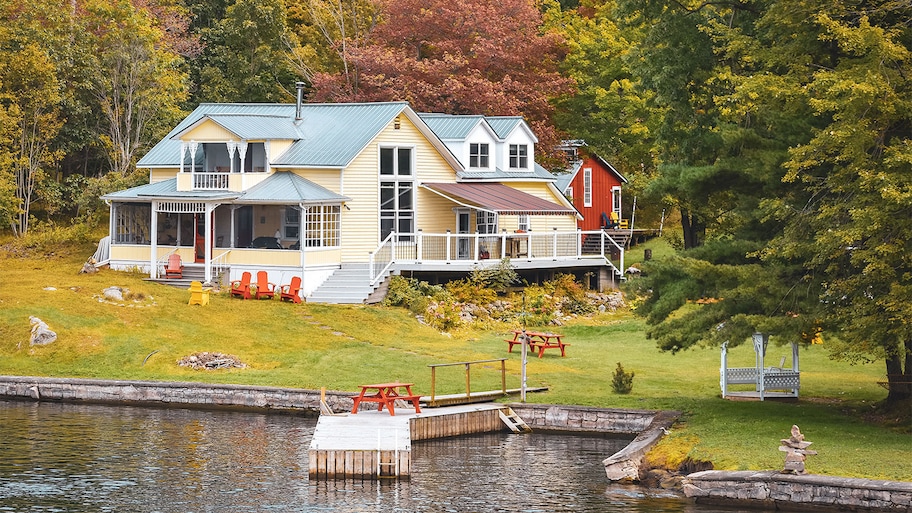Work with your homebuilding team to design a house ready to weather any storm
From seaside views to taking a daily dip in the lake, there's no question why we love to build homes by the water. However, many of these regions fall within a Special Flood Hazard Area (SFHA) designated by FEMA, which means your home is more susceptible to damage during a flood. While there's no way a home can ever be 100% flood-proof, thankfully, FEMA and local agencies specify the best materials, structural conditions, and homebuilding tips to protect you and your home in the event of a large storm.
Once you choose a local home builder highly experienced working with SFHAs, here are some flood-proof home tips to consider.
1. Learn Your BFE
You'll encounter a handful of acronyms and terminology when building a flood-proof home. One of the most common is BFE, or base flood elevation. FEMA defines the BFE as, "the elevation of surface water resulting from a flood that has a 1% chance of equaling or exceeding that level in any given year."
In this case, a 1% chance is more than enough of a threat to take special actions to protect your home. Doing so will also keep your insurance rates down. The National Flood Insurance Program (NFIP) will use the BFE of your property to set standards and propose insurance rates. For example, the lowest floor of your home—any fully enclosed living or storage space—must sit above the BFE. Areas below the BFE, such as garages or columns that raise your foundation, must be made of approved flood-resistant materials.
2. Opt for Flood-Resistant Materials
The NFIP categorizes common building materials into five classes based on their resistance to floodwaters. Keep in mind that these recommendations are the base level requirements for living in an SFHA. Even if your home is only mildly susceptible to flooding, highly rated materials may help lower your flood insurance rates and provide peace of mind during a rough storm season.
Any materials below the BFE must fall into class 4 or 5 to meet compliance. Here's a quick breakdown of what each class means:
Class 5: Resistant against significant damage (beyond cosmetic) in moving floodwaters. These are used for exterior and partially enclosed areas.
Class 4: Resistant against floodwaters, but not likely moving waters. It is possible to clean them after exposure to dangerous pollutants.
Class 3: Only resistant to damage when submerged in clean water.
Class 2: Cannot survive damage from clean water or floodwaters and should remain dry.
Class 1: Cannot survive when exposed to either type of water or a high moisture level.
While you can find the full list on FEMA's site, some level 4 and 5 materials include:
Brick
Cast stone
Cement board
Preservative-treated borate
Marine-grade plywood
Commingled plastic lumber with 80%–90% polyethylene
Steel trusses and beams
Solid, decay-resistant wood beams
Mortared ceramic and porcelain tile
Glass tile
3. Raise Your Home

With flood zones expanding, it's becoming more common to raise your home and keep the lowest floor above the BFE. The NFIP defines the "lowest floor" as the lowest enclosed area. You cannot use anything below here for a living space or electrical and mechanical equipment. In other words, it's not your traditional basement or storage area.
Raising an existing home can cost up to $18,500, so it's important to consider this option during the initial construction. Raised homes typically sit on reinforced masonry materials such as concrete or steel columns. You can also opt for approved class 4 or 5 types of wood to raise a home.
4. Relocate Utility Appliances
Hot water heaters, furnaces, and major electrical systems must be kept above the BFE in flood-prone areas as well. If the appliances sit below the lowest level of your home, contact your local heating specialist or plumber to discuss raising these appliances. For example, avoid a water heater catastrophe by either elevating it off the ground or installing it on a higher floor.
5. Choose the Right Insulation
Fortifying your walls against hydrostatic pressure can both keep water outside your home and protect against irreparable water damage in the wall's interior. Opt for insulation materials that fall within classes 4 or 5 based on FEMA's regulations. These include:
Sprayed polyurethane foam
Closed-cell plastic foams
Formed-in-place plastic flooring
6. Landscape with Proper Drainage

Regrading a sloped lawn and or adding supporting drainage will help direct water away from your home and into proper local storm drains. Installing landscape drainage costs an average of about $4,000 depending on the type of system right for your lawn. Lawn drainage systems include:
French drains
Trench drains
Underground downspouts
Yard inlets
Concrete or plastic catch basins
FEMA also recommends installing a backflow preventer in the event that sewage starts heading in the wrong direction during a flood.
7. Reinforce the Basement
While most homes in flood-prone areas must legally raise the house above the BFE, you may still opt for a basement in less-threatened areas. In this case, there are several steps you can take to prevent basement flooding. Seal the interior of your walls with waterproof paint and install a sump pump to control minor floods.
FEMA also sets standards for foundation flood vents that allow water to escape should you experience a large flood. You can also support your basement and crawlspace by properly draining and grading your landscape and directly gutter downspouts at least three feet away from your foundation.
8. Hire an Experienced Team
Most importantly, you don't need to go this alone. If you live in an SHFA, FEMA can assign you a floodplain manager. You can also hire local home builders with flood-proofing experience, particularly local specialists in landscape drainage and grading or in basement waterproofing.





